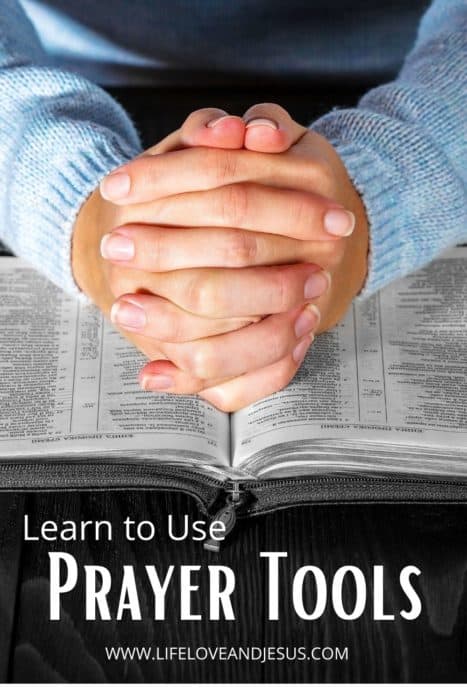Organize Your Prayer Life for Powerful Praying
This post contains affiliate links. If you click & make a purchase, I receive a commission! Thanks! Read my full disclosure policy. As an Amazon Associate, I earn from qualifying purchases.
How do you organize your prayer life? I shared a few years ago about my Faith Journal which helped me to be organized in my prayer life and other aspects of spiritual growth. But recently I switched to using a dedicated Prayer Journal.
Both journals were appropriate for the seasons I was (am) in. If my personal history has taught me anything, I suspect that my Prayer Journal will continue to change as I grow and change. In fact, looking further back, I’ve used many different tools to organize my prayer life, depending on the season I was in.

I know journals don’t work for everyone. Having a prayer journal didn’t always work for me. But I have always worked to organize my prayer life. You need to learn how to organize your prayer life for powerful praying. Because it does make a difference.
Maybe some of the tools I’ve used or heard about – discussed below – will help you to become the warrior on your knees that you desire to become.
Why You Should Organize Your Prayer Life
Maybe you’re thinking, “Does it really matter how my prayer life is organized?” Or, “Why would I need any system to organize my prayer life?” In a word: life!
Life pulls us in all sorts of directions. Kids have needs. Jobs have expectations. Relationships need nurturing. The simplest thing to do it seems is to hit the floor running and don’t stop until you drop into bed at night.

The problem with that plan (or seat-of-your-pants-lifestyle), is that the quiet, important tasks get overlooked and left undone all too frequently. I know because I’m a recovering ‘seat-of-your-pants’ person! And because I sometimes have days or even weeks that resemble chaos more than planning. During those times my prayer life takes a hit.
You can have the best of intentions to pray faithfully, but without a plan, you will fail more than succeed. The bad news is that doing nothing is almost our default setting as humans with a sinful nature.
The good news is that if you’ve given your heart to Jesus and make Him your Savior and Lord, you have full access to the “power of His resurrection” (Philippians 3:10). So your default setting is destined for defeat when you draw on the power that is yours.
Also good news: when you choose to organize your prayer life in one way, you aren’t locked in forever. As your life changes, so can your plans and tools for your prayer life.
The bottom line is this. With a plan, you will pray more frequently, more faithfully, and more powerfully. Without a plan, you won’t.
If you have a plan for your prayer life, you will pray more frequently, more faithfully, and more powerfully than if you don't have a plan. Organize Your Prayer Life for Powerful Praying Click To TweetOrganize Your Prayer Life with Index Cards
Index cards were my first prayer organization tool. They were easy, cheap, and portable. I began using index cards in college and continued for several years. My ring of cards went with me on vacation, to Bible study, on walks (great prayer time!), and in the car.
My index-card prayer plan was simple. I would write one person’s name on each card, or sometimes a family name. For example, my mom and dad went on one card, the missionary families I prayed from went on another card, my siblings and their families each got a card, and my church and pastor went on a separate card.
Although using index cards this way helped my prayer life, I could have made the system more focused and flexible. To use index cards most effectively in your prayer life, you might consider some of these ideas.

First, write out all your cards. List everyone and everything you pray for or think you should pray for. Determine if family members get grouped together or if each gets an individual card. Include cards for people and needs outside of your immediate circle as well. Global concerns, items on the news, foster children, revival. Whatever God places on your heart needs a card.
Next, take the cards you’ve written and make three stacks.
The first stack will be your daily stack. This might include your husband, children, grandchildren, and yourself. What you write on these cards is up to you. You might have both ‘long-term’ and ‘short-term’ cards.
For example, a long-term card might list a future spouse, strong faith as an adult, and healing from a serious illness such as cancer. A short-term card could include being sick with the flu, doing well on Friday’s test, not having issues with anxiety, or making good friends in a new school. One of the advantages of having both long-term and short-term cards is that you get to move more cards into stack #3 quickly!
The second stack would be your weekly cards. Your weekly cards would most likely include a variety of categories such as missionaries you know, your church and pastor, your local community, your job, business, and finances, your friends and extended family, and the government, global concerns, and special burdens you have. Each of those cards should have a letter in a corner indicating what day of the week you pray over those items.
The last stack of cards would be answered prayers. If you have a card for “VBS” or “the election” or “hurricane coming our way” or “salvation of Uncle Jim” – when these events occur or are past, write notes about how you saw God move. Then keep those cards to reflect on, return to when discouraged, and for times of praise, worship, and thanksgiving.
Finally, once your cards are written and organized, decide how & where to keep them. The only rule here is to make them easy to find and use. Some ideas to get your creative juices flowing:
- Use different colored binder clips for each category or day. Then place all clips on a chain or string to flip through
- Create multiple ‘daily’ cards to create one group for each day. Then hole-punch each day’s cards, place them on a ring and keep them on small hooks, one for each day. Grab the ring you need every morning and pray over the cards throughout the day.
- Purchase an index card box with daily dividers. You can easily grab the daily cards and each day’s cards out of the box during your devotions. Or, again, create multiple daily cards so you just grab each day’s cards before reading your Bible.
- Use mini-photo albums, like the type you can find at dollar stores. Have a separate album for each day.
- Keep the cards all together, but use washi tape on the edges as indicators of what day or days you pray over those cards.
The important thing, of course, is not how you organize the cards, but that you organize them in a way that makes it as easy as possible for you to use them daily.
Use a Prayer Calendar
You can find prayer calendars online by searching for them. Of course, you can also buy prayer calendars. Here are a few free calendars for you to consider.
- If you have a heart for persecuted believers, use the prayer calendar from Open Doors.
- This basic all-in-one calendar from Stacey Nickels has been around for a while but is still very clear and easy to use.
- Candace from Mercy is New has theme-based prayer calendars for each month of the year.
You can also make your own prayer calendar following these easy steps.
- Begin by brainstorming a list of everything you want to remember in prayer.
- Decide if you want to use theme weeks or theme months. Or if you prefer using a rotating schedule of prayer topics.
- Print a blank calendar for one or more months. Decide where each item on your brainstormed lists will go and begin writing them down. Some items may be repeated once or twice, while other items my be repeated daily.
- Keep this calendar with your Bible or planner to remind you to pray regularly.
- Finally, review your prayer calendar occasionally to add (or subtract) items that are no longer necessary, such as for your son to find a godly wife after he’s happily married. Of course, you’d replace that with praying for him as a husband and for their marriage relationship.

Use a Repeated Schedule
Instead of following a monthly calendar, you may want to just have a repeating weekly schedule. This index card method discussed above is built around this idea. But you can also use the same method using a notebook instead of index cards.
The Inspired by Grace Prayer Journal uses this repeating schedule method. The prayer topics and prayer lists for each topic are done for you and you just need to print, add your personal items, assemble them into a notebook, and use them. If you’re short on free time, this might be the easiest way to begin using this method.
If you’d rather build your own notebook or journal, follow the steps below
- Decide if you will use a 5-day schedule or a 7-day schedule.
- Choose the topics you need to include in your regular prayers. Some topics could be yourself, your spouse, your children, your job or business, your home responsibilities, your ministries, your friends & extended family, your church, missionaries, orphans, national or global concerns, and many more.
- Next, decide which topics will be daily – probably family and yourself. But there may be others as well.
- Then determine what days you will pray over the other issues. An example schedule for 7 days is below.
- M: Mission and Ministry Monday: praying for all things missionary and ministry-related
- T: Twisted Tuesday: praying for all those whose minds are twisted against the Gospel – the lost
- W: Worship Wednesday: praying for all things church-related
- T: Thankful Thursday: thanking the Father for all answered prayer
- F: Family Friday: praying for all extended family members
- S: Superhero Saturday: praying for first responders and military members
- S: Spirit Sunday: Praying as the Spirit leads
Use Your Phone
I don’t personally use any prayer apps and never have. If you’re interested in trying one, I’ve read good reviews about PrayerMate and Pocket Prayer. But, if you’re interested in one, you probably have friends that can steer you in the right direction better than I can.
In addition to using prayer apps, your phone can be used to organize your prayer life by using the alarm and timer functions.
The alarm function is great if you want a reminder to pray at 10 AM for your daughter’s math final or every day at 8 PM for your church’s current mission trip members. You could set an alarm to pray for a focus character trait every hour on the hour. The uses are endless – be creative.
The timer function is useful in a different way. If your prayer muscles are weak, set your timer for 5 minutes and pray until it goes off – no matter how challenging it is! If you’re more seasoned in prayer, list 6 or 12 items to pray for, and set the timer for 10 or 5 minutes respectively. You will find yourself praying for an hour! This one-hour prayer idea comes from Dick Eastman’s book The Hour That Changes the World. You can easily find the graphic for the hour online, but the book is well worth reading!
Pray God’s Word
Use the model prayers in the Bible to guide your personal prayer. Not limited to the Lord’s Prayer (Matthew 6:9-13), this also includes Paul’s prayers in the epistles ( Ephesians 1;17-19; 3:16-19; Philippians 1:9-11; Colossians 1:9-12), Daniel’s prayer of confession for his nation’s sin (Daniel 9:1-23), praying through the armor of God (Ephesians 6:10-18), the fruit of the Spirit (Galatians 5:22-23), or the characteristics of maturity (2 Peter 1:4-8). You could also use Praying God’s Word, by Beth Moore, or follow the 3 R’s of Praying Scripture: Rejoice, Repent, Request.
In the 3 R’s method, you choose a verse to pray, and then rejoice over the truth in the verse, repent of your failings related to the verse, and request a blessing for yourself based on the verse. For example, if you chose John 1:14, you could rejoice that Jesus came in the flesh to redeem us, repent of taking this awesome reality for granted and not praising enough for the incarnation of Jesus, and request that the Lord would open your eyes to the full grace and truth of this fact and that you would praise more often for this miracle.
Recommended Books on Prayer
Finally, if you want to learn more about prayer, spend some time in the presence of those who are intimately acquainted with the practice. If you can find a prayer mentor, great! But if not, choose one or more mentors through their written words.
- Fervent, by Priscilla Shirer
- 30 Days to Becoming a Woman of Prayer, by Stormie Ormartian (all her books on prayer are wonderful)
- The Daniel Prayer, by Anne Graham Lotz
- Too Busy Not to Pray, by Bill Hybels
- The Circle Maker, by Mark Batterson
- Lord, Teach Me to Pray in 28 Days, by Kay Arthur
If you want to get your prayer life under control, choose one of these suggestions and start today! I’d love to hear from you how it’s going, what is working for you, and anything you might suggest that I could add to this list.






